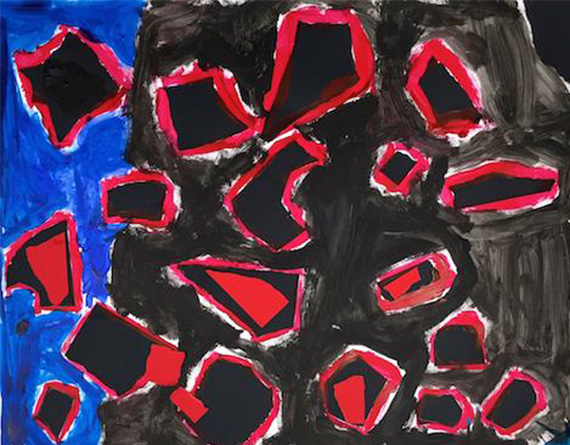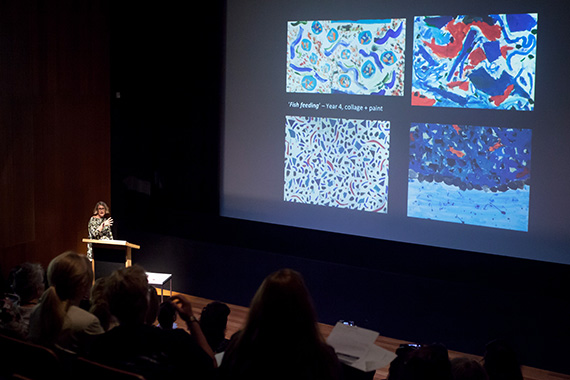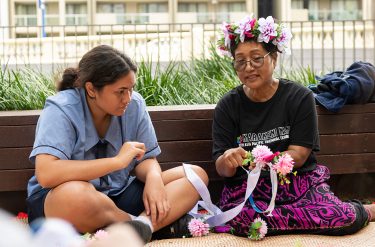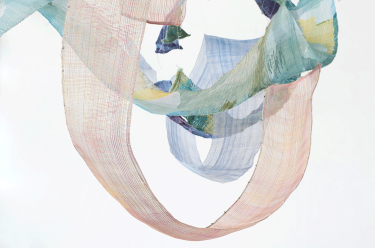The QAGOMA Learning team delivers professional development programs to empower Queensland teachers with practical and enjoyable approaches to explore contemporary Indigenous art in the Gallery and in the classroom.
Our recent program emerged out of an increase in the number of requests from educators for more on Indigenous perspectives and incorporating this in the classroom respectfully and authentically – at the centre of the program were people, artworks and culture. Our exhibitions Sally Gabori: Land of All, The Gabori Sisters: Gathering by the Sea and Line and Form brought together curators, teachers, learning staff and exclusive content. Teachers, who are trained in the Arts continue to engage with QAGOMA’s Indigenous Australian Art Collection, while a broader base of teachers who are working through the Australian Curriculum are now looking to the Visual Arts as an area to deepen their knowledge of Aboriginal and Torres Strait Islander life, culture and country.
The teachers who attended gained insight into Aboriginal and Torres Strait Islander perspectives through presentations from Valerie Rogers and Trish Honeywill, who are members of the QAGOMA Learning Teacher Advisory Group, curators and Tamsin Cull, Head of Public Engagement. Resoundingly, teachers expressed that hearing from the Gallery’s Indigenous Australian Art curators Diane Moon and Bruce McLean, as well as hearing how fellow educators were engaging with their students, were highlights of the professional development program. All presentations and learning resources are available online and onsite, including Children’s Art Centre labels and activities, Sally Gabori Learning resource and the QAGOMA Learning Online Collection Resource.
Practising teachers explored with their students the education resource developed for ‘Mirdidingkingathi Juwarnda Sally Gabori: Dulka Warngiid – Land of All’. Here is some feedback to the following question that triggered enriching learning experiences:
COUNTRY AND PLACE: THE INTERACTION BETWEEN BEING AND PLACE
Use colours, shades, tints and lines to create a pattern that illustrates the rhythm of natural abundance. Consider the movement, sound and energy that can be created when schools of fish come to the surface or flocks of birds pass above treetops.
For many of us, having the opportunity to use artworks by artists such as Sally Gabori to inspire children is wonderful. As is having access to resources that will enhance children’s explorations and experiences with art. Even more relevant, if like me, you have not trained to be an art teacher, but are a teacher of art. The gallery’s online educational resources are designed for all teachers and students. Valerie Rogers

Rogers focused on Sally Gabori’s All the fish in the education resource to talk about personal stories and connections to places of significance.
We talked about how and why some people feel more connected to certain places than others … we talked about how memories and stories are shared through artworks. Valerie Rogers
Using the ‘See, Think, Wonder’ developed by Harvard’s Visible Thinking, Rogers prompted children’s imaginations through close looking and open discussion.
- ‘What do you see?’ [To draw attention to details]
- Stating the artwork title and asking, ‘What do you think it’s about?’ [The scales were flashing in the sunlight. The big circles were the open mouths blowing the bubbles.]
- Storytelling – the circles represented the bubbles made by schools of fish Sally Gabori remembered feeding at her favourite fishing places on Bentinck Island. Children were fascinated with the number of circles and colours. ‘I wonder how many circles there are?‘ was a common ‘I wonder’ response.
Rogers then shared a video of rain falling on a fish pond. The prep students could see the bubbles and circles. It was the pattern and movement of the circles that seemed to get their attention. They went outside and used watering cans to see if the drops they made were the same spreading, moving circle pattern. Together they watched a tap drip into a container of water to look for moving circles.
Consolidating the students’ observations and explorations, it was time to get their hands on art materials: ‘How could you draw or paint that movement of rain falling? What story would your painting tell?‘ Children were given cartridge paper and the choice of acrylic paint or oil pastel. They had their own tray for mixing paints. Following the completion of their artworks, the class re-visited the concept of storytelling and memory sharing.
A CHILD’S RESPONSE
Rain is falling on a big pond. The raindrops are making little circles in the pond. I saw more and more circles because it was raining harder.
Another teacher, Trish Honeywill also engaged her Year 4 students with All the fish, drawing inspiration from the education resource to instil in her students ‘the confidence to discuss works that appear quite abstract in nature’.
They examined the painting according to size, its figurative/abstract nature, colour, shape and pattern. After knowing where and how Sally Gabori lived, the teacher asked, ‘does that offer any clues to the painting?’ Together they explored the theme, ‘abundance in nature’ and discussed their own personal experiences:
- cicadas at dusk
- parrots roosting/nesting at dusk – garden/shopping centre carpark
- water running through a stream, gutters
- a storm breaking after a hot day or drought; and
- fish feeding /fish farm
The students were invited to close their eyes and listen to 4 audio tracks – and to think of the colour, shapes and surface patterns and movement that the sounds brought to mind. Rather than a descriptive figurative image, the students were to interpret the sounds they were hearing. Tearing or cutting paper first to create a collage, they then added paint to think about the types of marks and strokes they created, developing further the use of colour. Free exploration

Overall these two classroom examples reflected the important role of QAGOMA as a catalyst for cultural and arts learning in Queensland schools.
Reflecting on the educator feedback received, many attendees reported they would expand their own confidence in teaching with and through Indigenous Australian art in the following ways:
- ‘I can take back to the classroom an added knowledge and understanding of Indigenous art and I’m inspired to learn more’
- ‘As we have Aurukun students at school – I now feel more capable of interacting with them’
- ‘I can use the program in teaching art, art history and even bring in geography when discussing Sally Gabori’
- ‘I can share the program with other teachers in the department’
- ‘I have the confidence to develop new programs and to reinforce current programs/reflection’





